
Transmission provider Allison Transmission (NYSE:ALSN) fell short of the market’s revenue expectations in Q1 CY2025, with sales falling 2.9% year on year to $766 million. On the other hand, the company’s full-year revenue guidance of $3.25 billion at the midpoint came in 2% above analysts’ estimates. Its GAAP profit of $2.23 per share was 8.7% above analysts’ consensus estimates.
Is now the time to buy Allison Transmission? Find out by accessing our full research report, it’s free.
Allison Transmission (ALSN) Q1 CY2025 Highlights:
- Revenue: $766 million vs analyst estimates of $790.9 million (2.9% year-on-year decline, 3.2% miss)
- EPS (GAAP): $2.23 vs analyst estimates of $2.05 (8.7% beat)
- Adjusted EBITDA: $287 million vs analyst estimates of $282.3 million (37.5% margin, 1.7% beat)
- The company reconfirmed its revenue guidance for the full year of $3.25 billion at the midpoint
- EBITDA guidance for the full year is $1.2 billion at the midpoint, above analyst estimates of $1.15 billion
- Operating Margin: 32.5%, up from 29.7% in the same quarter last year
- Free Cash Flow Margin: 20.2%, similar to the same quarter last year
- Market Capitalization: $7.86 billion
David S. Graziosi, Chair and Chief Executive Officer of Allison Transmission commented, "Allison is well-positioned to navigate current trade uncertainties, utilizing our global footprint to provide our North American customers with Made in USA products while supplying our Outside North America customers with on-highway products produced outside North America."
Company Overview
Helping build race cars at one point, Allison Transmission (NYSE:ALSN) offers transmissions to original equipment manufacturers and fleet operators.
Sales Growth
A company’s long-term sales performance is one signal of its overall quality. Even a bad business can shine for one or two quarters, but a top-tier one grows for years. Unfortunately, Allison Transmission’s 3.8% annualized revenue growth over the last five years was sluggish. This wasn’t a great result compared to the rest of the industrials sector, but there are still things to like about Allison Transmission.
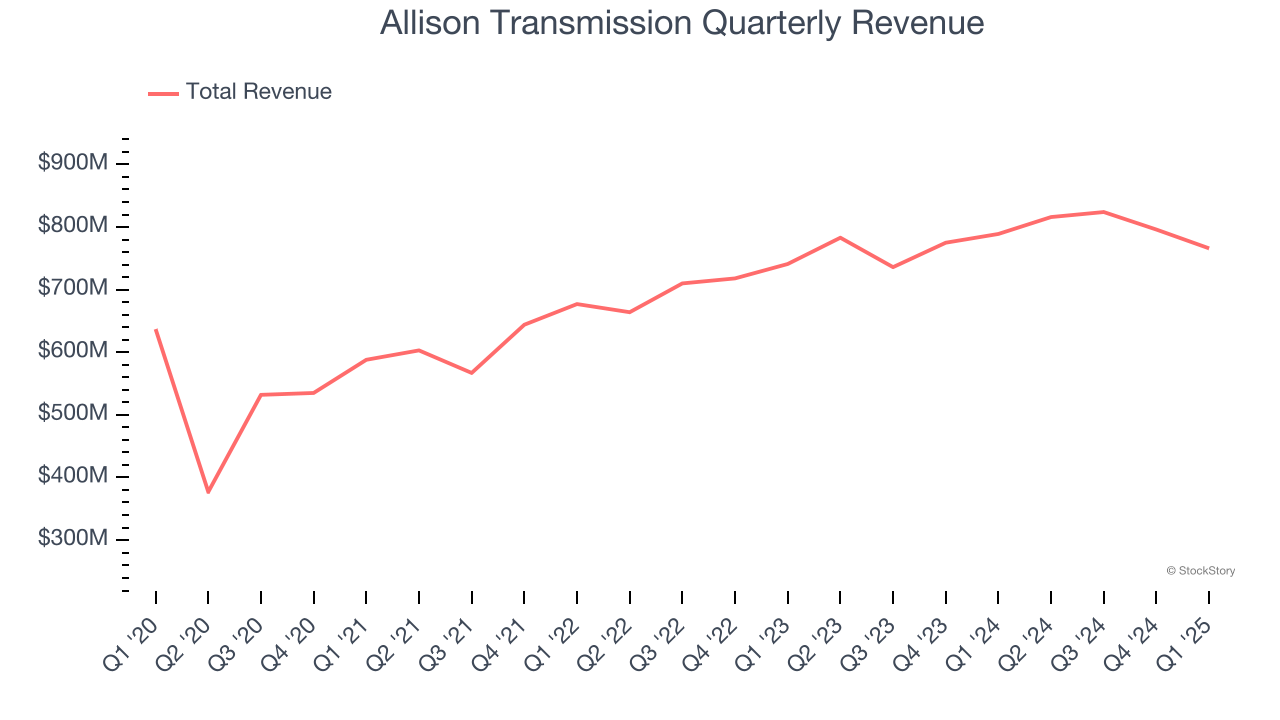
We at StockStory place the most emphasis on long-term growth, but within industrials, a half-decade historical view may miss cycles, industry trends, or a company capitalizing on catalysts such as a new contract win or a successful product line. Allison Transmission’s annualized revenue growth of 6.3% over the last two years is above its five-year trend, but we were still disappointed by the results. 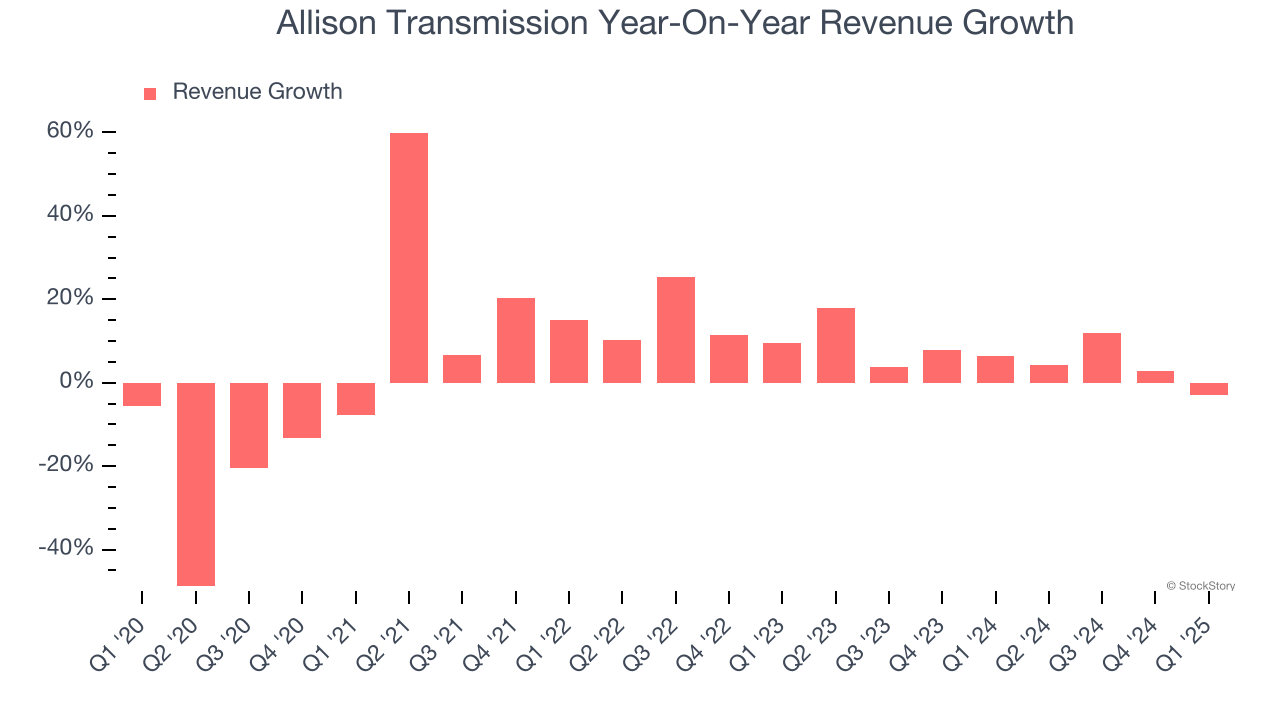
We can better understand the company’s revenue dynamics by analyzing its three most important segments: North America On-Highway, International On-Highway, and Service and Support, which are 56.8%, 14.6%, and 19.3% of revenue. Over the last two years, Allison Transmission’s revenues in all three segments increased. Its North America On-Highway revenue (propulsion solutions) averaged year-on-year growth of 12.9% while its International On-Highway (propulsion solutions) and Service and Support (parts and equipment) revenues averaged 3.3% and 2.4%.
This quarter, Allison Transmission missed Wall Street’s estimates and reported a rather uninspiring 2.9% year-on-year revenue decline, generating $766 million of revenue.
Looking ahead, sell-side analysts expect revenue to grow 2.4% over the next 12 months, a deceleration versus the last two years. This projection is underwhelming and implies its products and services will face some demand challenges. At least the company is tracking well in other measures of financial health.
Software is eating the world and there is virtually no industry left that has been untouched by it. That drives increasing demand for tools helping software developers do their jobs, whether it be monitoring critical cloud infrastructure, integrating audio and video functionality, or ensuring smooth content streaming. Click here to access a free report on our 3 favorite stocks to play this generational megatrend.
Operating Margin
Operating margin is an important measure of profitability as it shows the portion of revenue left after accounting for all core expenses – everything from the cost of goods sold to advertising and wages. It’s also useful for comparing profitability across companies with different levels of debt and tax rates because it excludes interest and taxes.
Allison Transmission has been a well-oiled machine over the last five years. It demonstrated elite profitability for an industrials business, boasting an average operating margin of 28.8%. This result isn’t surprising as its high gross margin gives it a favorable starting point.
Analyzing the trend in its profitability, Allison Transmission’s operating margin rose by 6.9 percentage points over the last five years, as its sales growth gave it operating leverage.
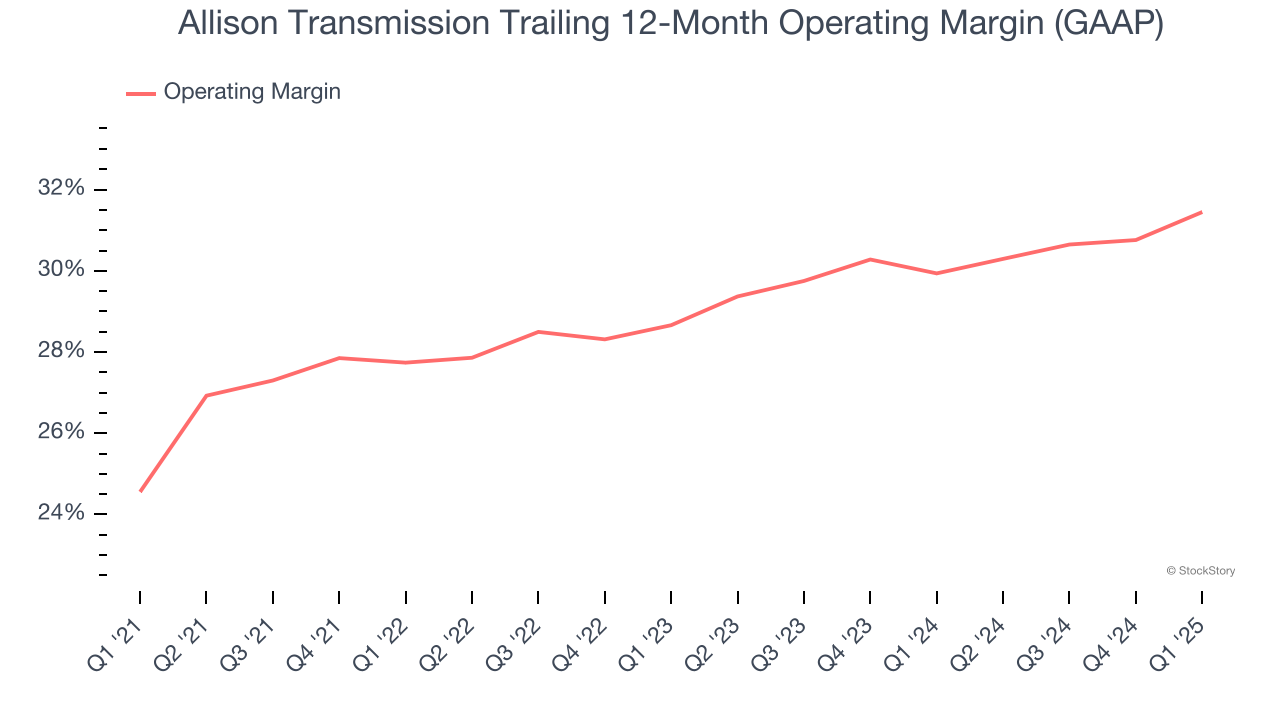
In Q1, Allison Transmission generated an operating profit margin of 32.5%, up 2.8 percentage points year on year. The increase was encouraging, and because its operating margin rose more than its gross margin, we can infer it was more efficient with expenses such as marketing, R&D, and administrative overhead.
Earnings Per Share
We track the long-term change in earnings per share (EPS) for the same reason as long-term revenue growth. Compared to revenue, however, EPS highlights whether a company’s growth is profitable.
Allison Transmission’s EPS grew at a remarkable 12.5% compounded annual growth rate over the last five years, higher than its 3.8% annualized revenue growth. This tells us the company became more profitable on a per-share basis as it expanded.
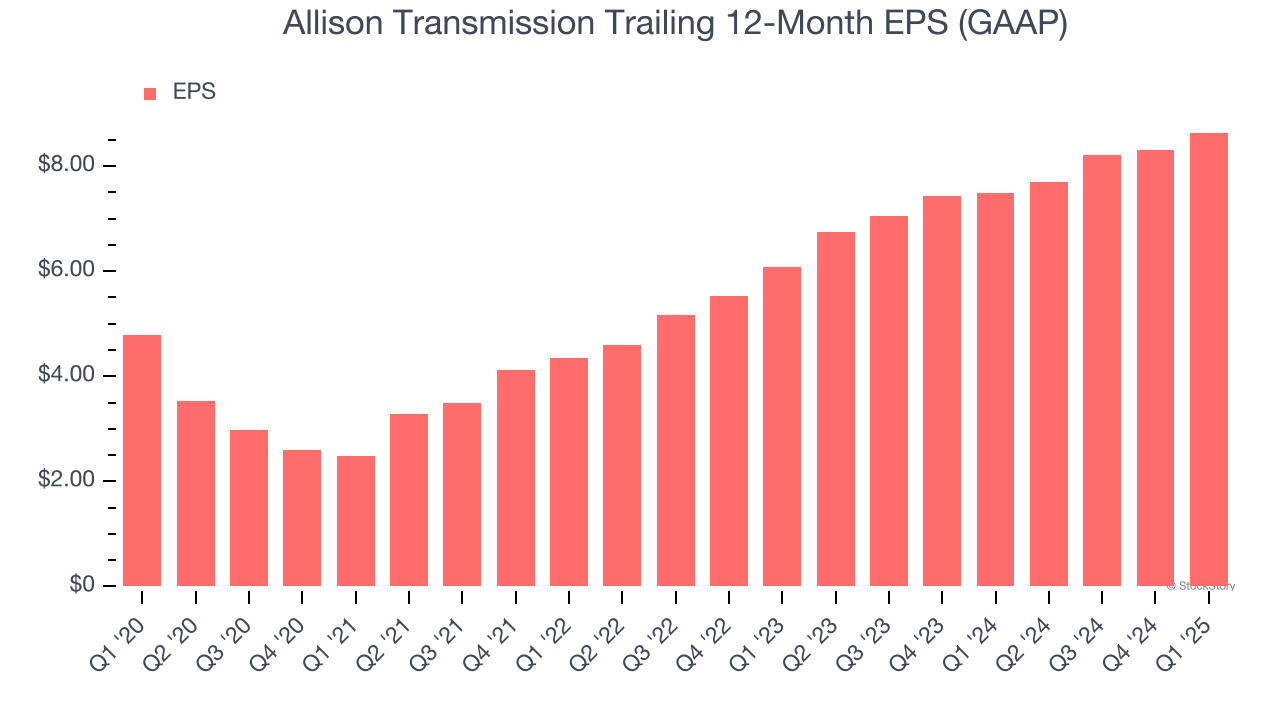
We can take a deeper look into Allison Transmission’s earnings quality to better understand the drivers of its performance. As we mentioned earlier, Allison Transmission’s operating margin expanded by 6.9 percentage points over the last five years. On top of that, its share count shrank by 25.9%. These are positive signs for shareholders because improving profitability and share buybacks turbocharge EPS growth relative to revenue growth. 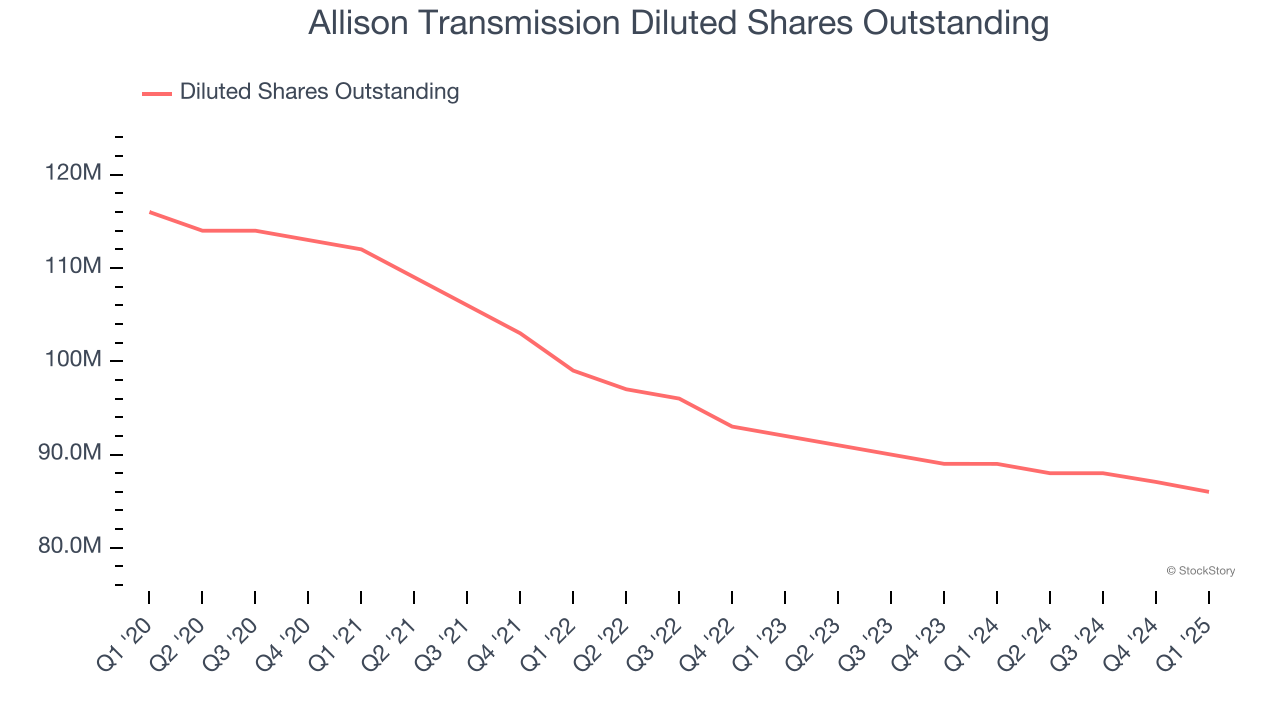
Like with revenue, we analyze EPS over a more recent period because it can provide insight into an emerging theme or development for the business.
For Allison Transmission, its two-year annual EPS growth of 19.3% was higher than its five-year trend. We love it when earnings growth accelerates, especially when it accelerates off an already high base.
In Q1, Allison Transmission reported EPS at $2.23, up from $1.90 in the same quarter last year. This print beat analysts’ estimates by 8.7%. We also like to analyze expected EPS growth based on Wall Street analysts’ consensus projections, but there is insufficient data.
Key Takeaways from Allison Transmission’s Q1 Results
We were impressed by Allison Transmission’s optimistic full-year EBITDA guidance, which blew past analysts’ expectations. We were also glad its full-year revenue guidance exceeded Wall Street’s estimates. On the other hand, its revenue missed significantly and its North America On-Highway revenue fell short of Wall Street’s estimates. Overall, this print was mixed but still had some key positives. The stock traded up 3.4% to $96.50 immediately after reporting.
Allison Transmission had an encouraging quarter, but one earnings result doesn’t necessarily make the stock a buy. Let’s see if this is a good investment. When making that decision, it’s important to consider its valuation, business qualities, as well as what has happened in the latest quarter. We cover that in our actionable full research report which you can read here, it’s free.
